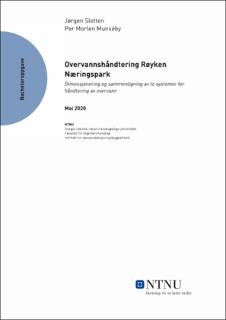| dc.contributor.advisor | Johansen, Fred Robert | |
| dc.contributor.author | Sletten, Jørgen | |
| dc.contributor.author | Munkeby, Per Morten | |
| dc.date.accessioned | 2020-07-28T16:00:51Z | |
| dc.date.available | 2020-07-28T16:00:51Z | |
| dc.date.issued | 2020 | |
| dc.identifier.uri | https://hdl.handle.net/11250/2670357 | |
| dc.description.abstract | Denne oppgaven tar utgangspunkt i de nye tomtene i Røyken Næringspark. Formålet med oppgaven er å finne ut hvilket overvannsystem som egner seg best på disse tomtene. I samarbeid med fagpersoner hos vår oppdragsgiver Isachsen Anlegg bestemte vi oss for to alternativer vi ville undersøke. Alternativ 1 med permeabelt dekke og grønt tak, og alternativ 2 med tette dekker, regnbed og blått tak. Kriteriene alternativene rangeres etter er først og fremst levetidskostnad, men vi har også vurdert miljøeffekt og krav til drift og vedlikehold.
Første steg i prosessen var å skaffe oss en oversikt over relevante bestemmelser som gjelder for tomtene, for så å lage et forslag på utforming av arealene på ei tomt. Deretter kunne vi detaljere og dimensjonere de to alternativene. Systemene er dimensjonert for 200-årsflom og vi har brukt en klimafaktor på 1,5. Ved beregning av kostnad har vi hentet inn pristilbud fra flere leverandører. Vi har utelatt elementer som er felles for begge alternativene, slik at kostnaden vi kom fram til ikke er den totale kostnaden for systemet, men et kostnadsgrunnlag for sammenligning.
Ved sammenligning av alternativene på pris er alternativ 2 det billigste. På både miljøeffekt og drift/vedlikehold scorer begge alternativene relativt likt, så dette påvirker ikke konklusjonen. En enda bedre løsning vil være å bruke elementer fra begge alternativene. Ved å bruke det permeable dekket fra alternativ 1 og det blå taket fra alternativ 2 får vi den optimale kombinasjonen av tiltakene vi har undersøkt i denne oppgaven. Dette gir den laveste prisen og den beste håndteringen av ekstrem nedbør. | |
| dc.description.abstract | The base of this bachelor thesis is the new building plots in Røyken industrial park. The purpose of the thesis is to decide which stormwater system that is most suitable for these plots. In cooperation with professionals at our employer Isachsen Anlegg we decided on two alternatives we wanted to investigate. Alternative 1 with permeable pavement and green roof, and alternative 2 with impermeable pavement, rain garden and blue roof. The criteria the alternatives are ranked by are first and foremost life cycle cost, but we have also considered environmental impact and requirements for operation and maintenance.
The first step in the process was to get an overview over relevant regulations that apply to the plots, and then make a proposed layout of the areas on the plot. Thereafter we could detail and dimension the two alternatives. The systems are dimensioned for a 200-year flood and all rain intensities are multiplied by a factor of 1,5 to take into account increased precipitation in the future caused by climate change. When calculating the cost of each system we have gathered price offers from multiple suppliers. We have excluded elements that both alternatives have in common, such that the cost we calculated is not the total cost of the systems, but a cost basis for comparison.
When comparing the alternatives on cost we see that alternative 2 is cheaper. Both alternatives get similar results on environmental impact and operation and maintenance, so this does not affect the conclusion. An even better solution would be to use elements of both alternatives. By using the permeable pavement from alternative 1 and the blue roof from alternative 2 we achieve the optimal combination of the measures investigated in this thesis. This gives the lowest cost and the best handling of extreme precipitation. | |
| dc.publisher | NTNU | |
| dc.title | Overvannshåndtering Røyken Næringspark | |
| dc.type | Bachelor thesis | |
